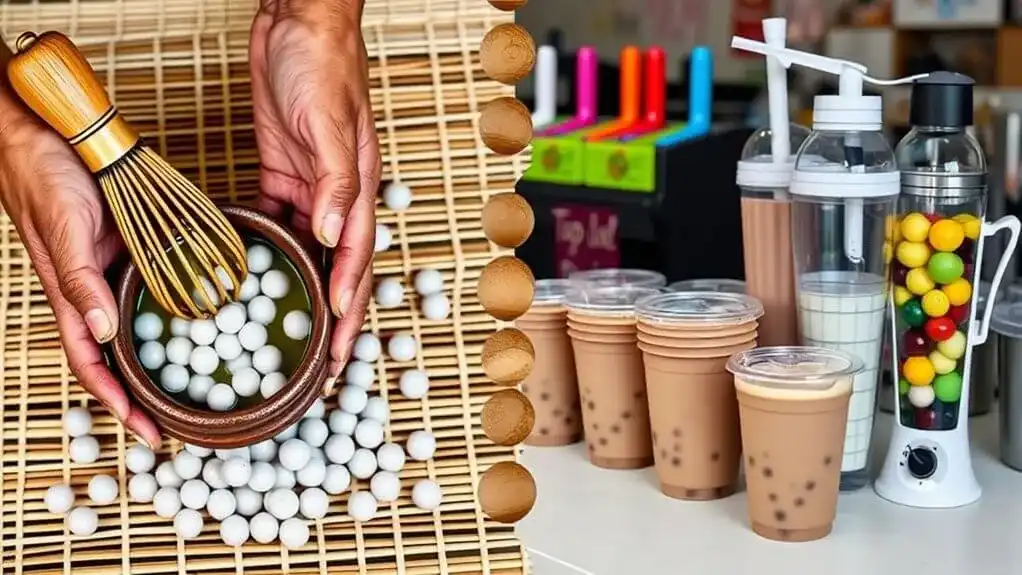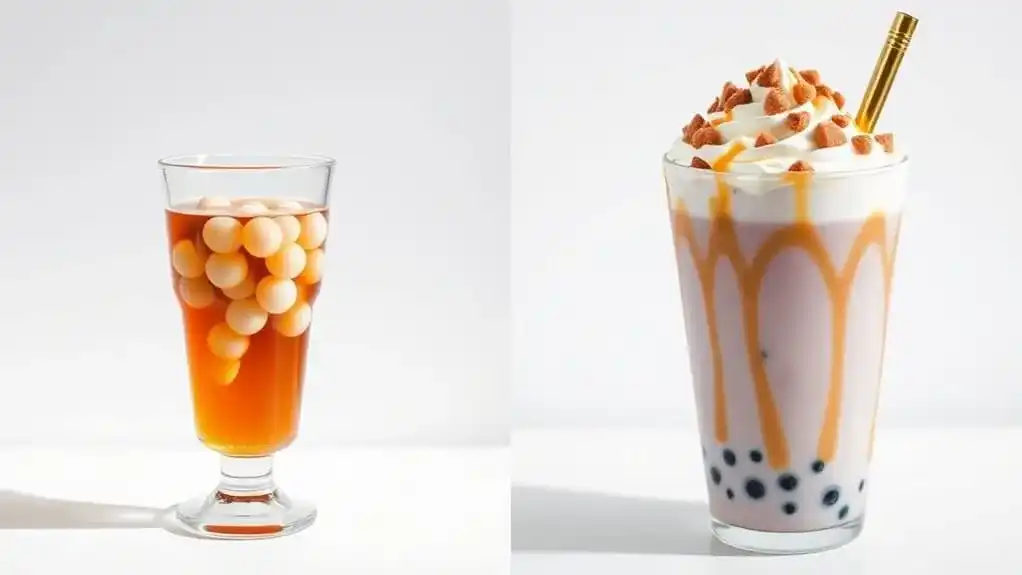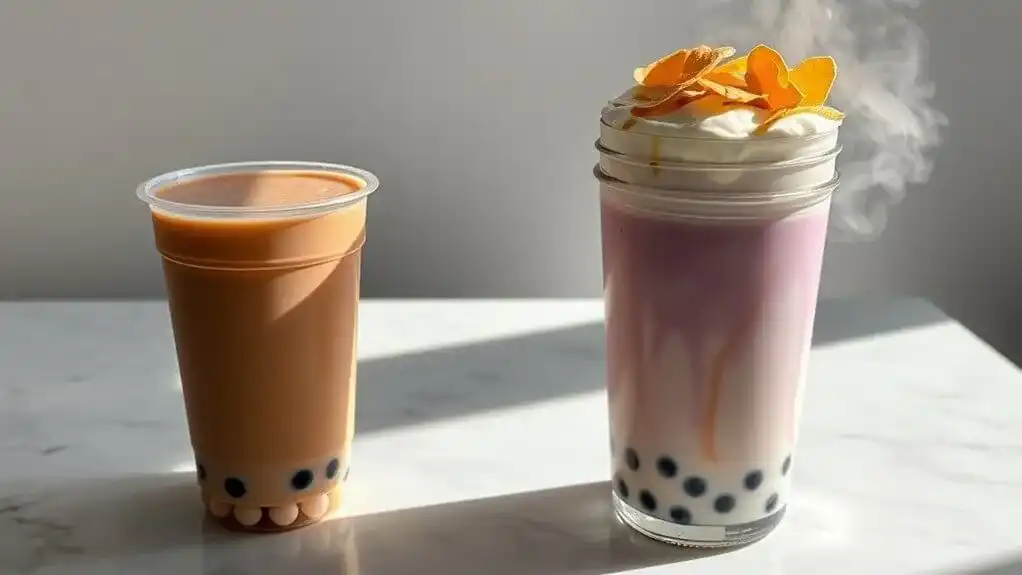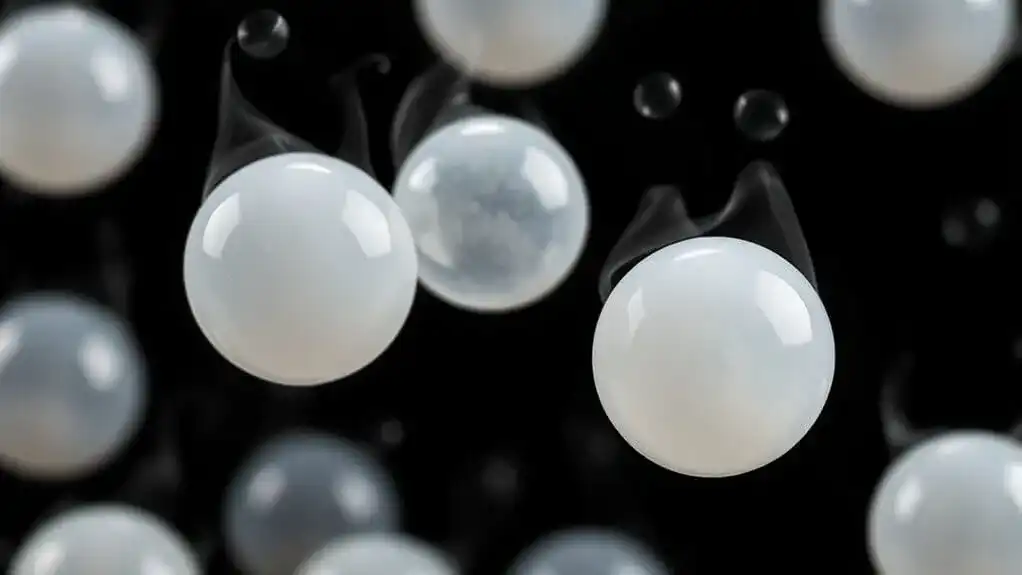Bubble tea's journey from 1980s Taiwan to global phenomenon showcases the drink's remarkable evolution. Traditional boba featured simple black tea with chewy tapioca pearls, prepared using the classic 30 & 30 method. Today's modern versions incorporate diverse flavors, health-conscious ingredients, and sustainable practices while maintaining the drink's cultural essence. From vitamin-infused pearls to plant-based options, boba continues to adapt to changing consumer preferences, proving there's much more to this beloved beverage's story.
Key Points
- Traditional boba originated in Taiwan during the 1980s using Ceylon tea, non-dairy creamer, and classic tapioca pearls.
- Modern boba incorporates diverse tea bases, fruit flavors, and innovative toppings to cater to evolving consumer preferences.
- Health-conscious adaptations now include low-sugar options, vitamin-infused pearls, and plant-based alternatives to traditional ingredients.
- Sustainability drives modern boba evolution with eco-friendly packaging and locally sourced ingredients replacing traditional practices.
- While traditional boba follows the 30 & 30 preparation method, modern versions utilize advanced brewing technology for enhanced flavors.
The Birth of Bubble Tea in Taiwan's Tea Houses
While the exact origins of bubble tea remain disputed between two prominent Taiwanese tea houses, its creation in the early 1980s revolutionized Taiwan's tea culture. Two compelling origin stories compete for recognition: Chun Shui Tang claims Lin Hsiu Hui invented the drink in 1988 by adding tapioca pearls to iced tea during a staff meeting, while Hanlin Tea Room asserts Tu Tsong-he created it in 1986, drawing inspiration from traditional Taiwanese snacks. The cultural significance of bubble tea extends beyond its innovative recipe, representing a fascinating fusion of old and new. Drawing influence from Japanese iced coffee and dessert traditions, this beverage marked a dramatic shift from traditional Chinese tea, quickly becoming a symbol of Taiwan's evolving culinary landscape and its ability to blend cultural influences. A decade-long legal battle over the drink's origin finally ended when courts determined that no single creator could claim the invention. The unique name comes from the frothy bubbles created when vigorously shaking the tea mixture during preparation. Today's bubble tea shops offer countless variations with customizable options to suit individual preferences.
Essential Elements of Classic Boba Preparation

The hallmark of authentic boba tea lies in its meticulous preparation process and carefully selected ingredients. The heart of boba's charm centers on proper tapioca preparation, which traditionally follows the 30 & 30 method for ideal texture and flavor balance.
The classic preparation demands precision at every step:
- Boiling fresh tapioca pearls until they float, then simmering for 30 minutes
- Allowing pearls to rest for another 30 minutes to achieve the perfect chewy consistency
- Rinsing under cold water to maintain the perfect texture
- Combining with carefully steeped Ceylon tea and non-dairy creamer
While modern variations experiment with different bases and toppings, these fundamental steps remain vital for creating authentic boba tea. The careful balance of ingredients guarantees each element complements the others, delivering the signature taste that's made this Taiwanese drink globally popular. Today's bubble tea shops offer an astounding 157 unique drinks to cater to evolving tastes. For optimal freshness and quality, cooked pearls should be consumed quickly after preparation to prevent them from becoming overly gummy. Many enthusiasts enjoy hosting bubble tea parties to share their love of this beloved beverage.
Game-Changing Innovations That Shaped Modern Boba

Modern boba's evolution has transformed traditional tea shops into high-tech beverage laboratories, where innovative brewing techniques and sustainable practices reshape the industry. Advanced brewing technology has revolutionized flavor extraction through precise temperature control and automated systems, ensuring consistent quality in every cup. The shift from exclusively using black Ceylon tea to incorporating diverse tea bases reflects growing consumer preferences. The Taiwanese origin of boba in the 1980s set the foundation for this remarkable transformation.
Today's boba shops prioritize sustainability with biodegradable packaging and locally sourced ingredients, while catering to health-conscious consumers through vitamin-infused pearls and probiotic additions. Leading brands like BobaVida are introducing flavor-changing pearls that provide an exciting multi-sensory experience. The visual presentation has also evolved, featuring edible flowers, interactive DIY experiences, and augmented reality packaging that engages customers in new ways.
These innovations extend beyond mere aesthetics, as modern establishments now offer customizable orders with unique toppings like popping boba and superfood additions, creating a more personalized and nutritious beverage experience that appeals to contemporary tastes.
Global Adaptations and Contemporary Flavor Trends

As boba tea's influence spreads across continents, innovative adaptations have transformed this Taiwanese beverage into a global phenomenon that reflects diverse cultural preferences. Local adaptations have given rise to unique regional variations, with global flavors drawing inspiration from different culinary traditions worldwide. The drink's remarkable transition from niche to mainstream has particularly resonated with younger generations. The customizable nature of bubble tea allows customers to adjust sweetness levels according to their taste preferences. The aesthetic appeal of these beverages has made them highly shareable content on platforms like Instagram.
Today's boba landscape showcases this evolution through:
- Matcha-based drinks and fruit-infused teas in Western markets
- Plant-based milk alternatives and sugar-free options for health-conscious consumers
- Traditional Asian ingredients like grass jelly and aiyu meeting modern toppings like popping boba
- Regional specialties incorporating local ingredients and cultural preferences
Social media has accelerated boba's transformation, turning these shops into trendy gathering spots while fostering cultural exchange. The industry continues to evolve, blending traditional elements with contemporary innovations to satisfy an increasingly diverse global palate.
Health-Conscious Evolution and Sustainable Practices

Building upon boba's global evolution, today's consumers are driving significant changes in how bubble tea is produced and consumed. Modern bubble tea shops are adapting to meet growing demands for health benefits by introducing low-sugar options, natural ingredients, and alternative milk choices. Many establishments now incorporate functional ingredients like probiotics and adaptogens to enhance their drinks' nutritional value. Traditional single-use cups are being phased out as shops embrace plant-based alternatives.
Leading companies like Easy Boba are revolutionizing the industry with recyclable PET cans that maintain drink freshness while minimizing environmental impact. The industry's shift toward eco-friendly practices is equally notable. Businesses are embracing biodegradable materials, reducing plastic waste through innovative packaging solutions, and sourcing ingredients locally. Companies that prioritize sustainability aren't just helping the environment – they're gaining a competitive edge as consumers increasingly favor environmentally conscious brands. This transformation suggests a promising future where technology and innovation will continue to shape boba's development, making it both healthier and more sustainable.
Conclusion
Boba's journey from a simple Taiwanese tea house creation to a global phenomenon mirrors life's sweetest transformations. While traditional preparation methods remain the heart and soul of bubble tea, modern innovations and health-conscious adaptations have propelled it into the future. Today's boba culture isn't just about the drink – it's become a bridge between generations, cultures, and evolving tastes, proving that some traditions are meant to grow.

